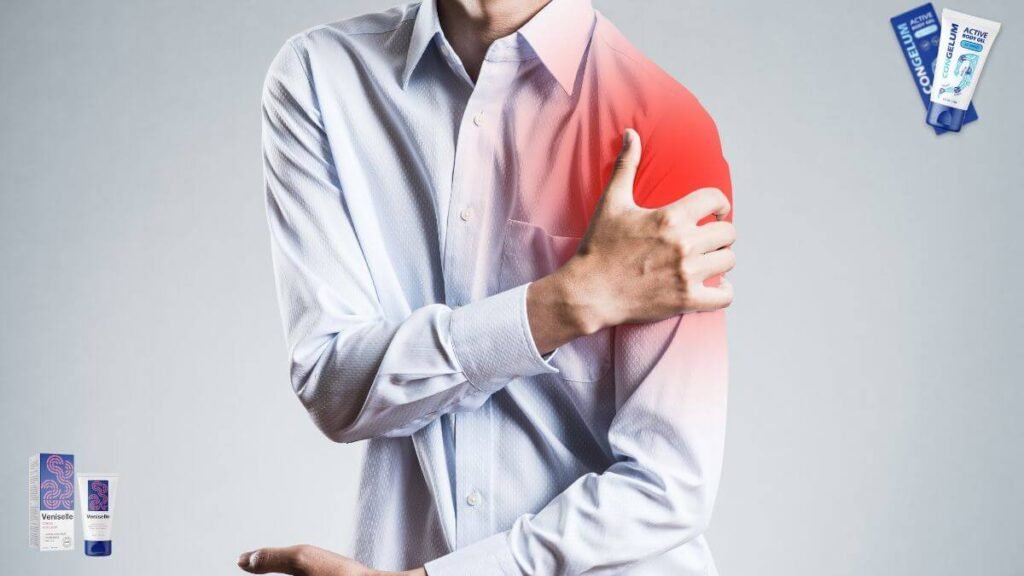Getting Started: Left Shoulder Pain ICD 10 Code
If you’ve ever experienced left shoulder pain, you know that it can be more than just an uncomfortable nuisance. It can affect your ability to work, exercise, or even go about your daily tasks. Whether it’s a dull ache, a sharp stabbing pain, or a constant stiffness, left shoulder pain can be a complex issue that requires careful attention. You might have already heard about the ICD 10 code for left shoulder pain but aren’t sure exactly what it means or how it relates to your treatment options. Don’t worry — you’re in the right place.
Discover our natural products store: SALE SUPRA
Discover the power of VENISELLE & CONGELUM
In this detailed guide, we’ll walk you through the anatomy of left shoulder pain, the ICD 10 coding system, potential causes, common symptoms, and various treatments that can bring you relief. From managing the pain with simple lifestyle changes to exploring more advanced treatment options, including Veniselle and Congelum, this article is packed with insights to help you understand and address left shoulder pain. Left shoulder pain ICD 10 code
What is the ICD 10 Code for Left Shoulder Pain?

Before diving deeper into understanding the condition, it’s important to first clarify what the ICD 10 code is. The International Classification of Diseases (ICD) is a medical coding system used worldwide to categorize diseases, symptoms, and various other health conditions. The ICD 10 code for a particular ailment allows healthcare providers to document the diagnosis in a standardized way, facilitating consistent treatment across different medical settings.
For left shoulder pain, the ICD 10 codes can vary depending on the underlying cause. Here are some of the most common ICD 10 codes related to left shoulder pain:
- M25.512: Pain in the left shoulder.
- M75.1: Rotator cuff syndrome, which is one of the most common causes of shoulder pain.
- M54.5: Low back pain, which might radiate to the shoulder and cause discomfort in the left shoulder region.
These codes are important for accurate documentation and billing purposes, as they help doctors assess, treat, and monitor the condition over time. Left shoulder pain ICD 10 code
Understanding the Causes of Left Shoulder Pain

What Causes Left Shoulder Pain?
Shoulder pain can have a variety of causes, ranging from simple muscle strain to more serious conditions like heart problems. Identifying the root cause of your pain is essential for effective treatment. Let’s explore the most common causes of left shoulder pain: Left shoulder pain ICD 10 code
1. Rotator Cuff Injuries
The rotator cuff is a group of four muscles and their tendons that help stabilize the shoulder. Overuse, injury, or degeneration from aging can cause inflammation or tears in these muscles. This condition is one of the leading causes of shoulder pain, particularly in athletes or people who engage in repetitive overhead movements, like lifting or swimming.
Rotator cuff injuries may be acute (due to an injury) or chronic (developing over time due to wear and tear). These injuries often lead to pain, weakness, and a limited range of motion in the affected shoulder.
2. Frozen Shoulder (Adhesive Capsulitis)
Frozen shoulder is a condition where the connective tissue around the shoulder joint thickens and tightens, restricting the movement of the joint. The condition is more common in people between the ages of 40 and 60 and can occur without any obvious cause. People with frozen shoulder often experience pain, especially during movement, and a gradual loss of motion in the shoulder. The condition may progress through three stages: freezing, frozen, and thawing.
3. Shoulder Impingement
Shoulder impingement occurs when the tendons of the rotator cuff become compressed between the bones of the shoulder. This condition is common in individuals who engage in overhead activities, such as painting, lifting, or throwing. The compressed tendons cause pain, especially when raising the arm or moving it in certain directions.
4. Heart-Related Issues
It’s important to note that left shoulder pain can sometimes be a symptom of heart problems, such as a heart attack or angina. Pain originating from the heart often radiates to the left shoulder, jaw, or arm. This can be especially concerning if accompanied by other symptoms such as chest tightness, shortness of breath, or sweating. If you experience these symptoms, it’s crucial to seek emergency medical attention immediately.
5. Arthritis
Arthritis in the shoulder joint can also lead to left shoulder pain. The most common forms of arthritis affecting the shoulder are osteoarthritis and rheumatoid arthritis. Osteoarthritis occurs when the cartilage in the shoulder joint wears down over time, leading to bone-on-bone friction, stiffness, and pain. Rheumatoid arthritis, an autoimmune disease, causes inflammation in the joints, including the shoulders, leading to pain and reduced mobility.
Recognizing Symptoms of Left Shoulder Pain

Symptoms to Be Aware Of
Not all shoulder pain is created equal. Recognizing the type of pain and accompanying symptoms can help determine the underlying cause. Below are common symptoms associated with left shoulder pain:
1. Limited Range of Motion
If you find it difficult to lift your arm or perform certain movements, such as reaching overhead or behind your back, it could indicate a rotator cuff tear or frozen shoulder. Left shoulder pain ICD 10 code
2. Pain During Movement
Shoulder pain that is aggravated by certain movements, especially lifting the arm or rotating it, is common in conditions like rotator cuff injuries or shoulder impingement.
3. Tenderness and Swelling
Conditions such as arthritis or tendinitis can lead to swelling around the shoulder joint, making it tender to the touch. Swelling may be accompanied by a feeling of warmth or redness in the affected area. Left shoulder pain ICD 10 code
4. Weakness in the Shoulder
Shoulder weakness, or the inability to lift objects with the affected arm, can be a sign of muscle or tendon damage, such as in rotator cuff tears or impingement.
5. Numbness or Tingling
If you experience numbness or tingling sensations in your arm, hand, or fingers, this could indicate nerve compression. Conditions such as herniated discs or nerve impingement in the cervical spine can lead to referred pain in the shoulder. Left shoulder pain ICD 10 code
Treatment Options for Left Shoulder Pain

How to Treat Left Shoulder Pain
Once you’ve identified the underlying cause of your left shoulder pain, the next step is treatment. While some cases of shoulder pain can be resolved with simple at-home remedies, others may require more advanced treatment options. Below are various treatments you may consider: Left shoulder pain ICD 10 code
1. Physical Therapy
Physical therapy is often the first-line treatment for most shoulder injuries. A trained therapist will guide you through exercises designed to strengthen the muscles around the shoulder and improve flexibility. This can help reduce pain, improve mobility, and prevent further injury. Left shoulder pain ICD 10 code
2. Medications
Non-steroidal anti-inflammatory drugs (NSAIDs), such as ibuprofen or acetaminophen, can help reduce pain and inflammation. For more severe cases, your doctor may recommend corticosteroid injections or other stronger medications to alleviate inflammation in the joint. Left shoulder pain ICD 10 code
3. Surgical Intervention
In cases where conservative treatments like physical therapy or medications fail, surgery may be necessary. Common procedures include arthroscopy to repair torn rotator cuff tendons or release adhesions in the shoulder joint (for frozen shoulder). Left shoulder pain ICD 10 code
4. Alternative Treatments: Veniselle and Congelum
In addition to conventional treatments, supplements like Veniselle and Congelum may provide relief. Veniselle is designed to reduce inflammation and improve blood circulation, supporting joint health. Congelum, on the other hand, focuses on reducing pain and enhancing joint mobility by delivering specific nutrients that promote cartilage repair. While these supplements should not replace traditional treatments, they can complement your recovery process. Left shoulder pain ICD 10 code
Prevention Tips for Left Shoulder Pain
How to Prevent Left Shoulder Pain
While it’s not always possible to prevent shoulder pain, there are steps you can take to reduce the risk of injury. Here are a few key prevention tips: Left shoulder pain ICD 10 code
1. Maintain Proper Posture
Poor posture, especially while sitting or standing for long periods, can put unnecessary strain on your shoulder joints. Ensure that your workstation is ergonomically designed, and practice proper posture throughout the day. Left shoulder pain ICD 10 code
2. Strengthen the Muscles Around the Shoulder
Regular strengthening exercises for the shoulder muscles, including the rotator cuff and upper back, can help support the joint and prevent injuries. Incorporating resistance training into your routine can build the necessary muscle strength for shoulder stability. Left shoulder pain ICD 10 code
3. Avoid Repetitive Overhead Movements
Repetitive overhead movements, such as lifting heavy objects or reaching overhead, can place excessive strain on the shoulder joint. Take breaks, and be mindful of how you move to prevent overuse injuries.
4. Stretch Regularly
Stretching is essential for maintaining flexibility in your shoulders and preventing tightness. Incorporate shoulder stretches into your daily routine to keep the muscles and tendons flexible and less prone to injury. Left shoulder pain ICD 10 code
The Final Takeaway
Understanding the left shoulder pain ICD 10 code and its associated causes, symptoms, and treatments is crucial for managing your condition effectively. From identifying the root cause of your pain to exploring treatment options like physical therapy, medications, and supplements such as Veniselle and Congelum, there are many ways to find relief. Left shoulder pain ICD 10 code
If you’re struggling with left shoulder pain, take the time to evaluate your symptoms, seek professional advice, and implement the right treatment plan. By taking care of your shoulder health, you can regain mobility and live a more active, pain-free life. Left shoulder pain ICD 10 code
FAQ – Frequently Asked Questions
What is the ICD 10 code for left shoulder pain?
The ICD 10 code for left shoulder pain is M25.512, specifically for pain in the left shoulder. There are additional codes depending on the underlying cause, such as M75.1 for rotator cuff syndrome.
Can left shoulder pain indicate a heart attack?
Yes, left shoulder pain can sometimes be a sign of a heart attack, particularly if it’s accompanied by chest pain, shortness of breath, or sweating. Seek immediate medical attention if you suspect this.
What are some at-home remedies for left shoulder pain?
Rest, ice packs, and over-the-counter anti-inflammatory medications can help manage shoulder pain at home. Gentle stretching and strengthening exercises can also improve mobility.
How does physical therapy help with left shoulder pain?
Physical therapy focuses on improving the range of motion and strengthening the muscles around the shoulder joint. This can reduce pain, improve function, and prevent future injuries.
What are Veniselle and Congelum?
Veniselle and Congelum are dietary supplements designed to reduce inflammation and support joint health. They can be helpful in managing pain and promoting mobility but should be used alongside traditional treatments.
Is surgery necessary for left shoulder pain?
Surgery may be necessary in severe cases where conservative treatments, such as physical therapy and medications, do not provide relief. Common surgical procedures include arthroscopy to repair torn tendons or release adhesions.

I’m an economist with 15 years of experience in strategic planning and a lifelong passion for wellness and natural living. As a self-learner, I created Herbalife Balance to share insights on healthy eating, mindful habits, and an active lifestyle. Tennis enthusiast and nature lover, I believe in balance as a path to well-being. Through this blog, I help others live healthier, more conscious lives.









